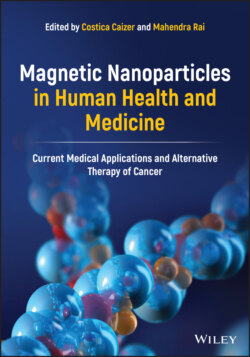Читать книгу Magnetic Nanoparticles in Human Health and Medicine - Группа авторов - Страница 51
3.4 Theranostic Relevant Examples
ОглавлениеThe main problem for the use of magnetic nanoparticle in therapeutic treatments is the suitable concentration of nanoparticles at the target. Specifically, in magnetic hyperthermia, the local increase of temperature is mainly due to a mass effect of several nanoparticles that “heat” the whole region. As claimed in a paper from Pellegrino's group, the single‐particle heating capability is limited to 0.5 nm from the nanoparticles surface (Riedinger et al. 2013). Many research groups overcome this limitation injecting, as proof of concept application, magnetic nanoparticles into the solid tumor. This methodology is accepted to validate the efficacy of novel nanomaterial, but it is not useful in clinical. Other groups injected nanoparticle intravenously, but with very high iron concentration, far from values usually approved by FDA. Albarqi et al. started from the synthesis of alternative nanomaterials to exploit the clustering for delivery of a high quantity of material to the tumor mass. The exotic nanomaterials are based on the synthesis of hexagonal iron oxide nanoparticles doped with cobalt and manganese (CoMn‐IONPs). These elements were incorporated in the crystal lattice of iron oxide, leading to an enhancement of the magnetic properties. Moreover, nanoparticles with a different surface magnetic anisotropy, based on cubic or hexagonal shape, showed a superior heating performance recently. The CoMn‐IONPs show a diameter of 14.80 ± 3.52 nm, with a dopant concentration of 8% for cobalt and 5% for manganese. These nanoparticles possessed a saturation magnetization of 93 emu g−1, higher than iron oxide nanoparticles, and a very high SAR of 1718 W g−1, measured in an organic solvent at 420 kHz with an applied field of 26.9 kA m−1. CoMn‐IONP nanoclusters were obtained by a solvent evaporation process, by using a pegylated poly(ε‐caprolactone), with a hydrodynamic size of 80 nm. After water‐transferring in clusters, the SAR value is still suitable for therapeutic approach (1237 W g−1) and higher than the value obtained with a suspension of single nanoparticles in water (997 W g−1), as an effect of strong magnetic dipole−dipole interactions into the cluster core. Concerning the in vivo experiment, CoMn‐IONP nanoclusters were intravenously injected in nude mice grafted with a xenograft subcutaneous tumor. The clusters were detected in the tumor after 10 minutes, with a maximum accumulation after 5 hours and a decrease after 24 hours. The application of an alternating magnetic field (10 minutes), 12 hours after nanocluster injection, induced temperature increase up to 44 °C. The application of four hyperthermia cycles within 30 days inhibited the growth of subcutaneous ovarian tumors in comparison to control groups (Albarqi et al. 2019) (Figure 3.3).
Figure 3.3 Schematic illustration of the nanoclusters prepared by encapsulation of hexagon‐shaped cobalt‐ and manganese‐doped iron oxide nanoparticles (a). NIR fluorescence biodistribution analysis at various time points after i.v. injection (b).
Source: Reprinted with permission from Albarqi et al. (2019). Copyright 2019 American Chemical Society.
In another relevant study, Nie et al. modified one of the synthetic methods described in Section 3.1 for the preparation of small nanoclusters for the release of active compound in a T‐cell therapy approach. The cluster was obtained by a solvothermal method in argon atmosphere, mixing iron sulfate, polyethyleneimine (PEI) in a mixed solution of EG/DEG and inducing nanoparticles nucleation by addition of NaOH/DEG at 220 °C. The obtained nanocluster exposed primary amine groups on the surface because of PEI molecules; these groups were then exploited for the conjugation of a benzaldehyde‐PEG2000‐tetrazine, where benzaldehyde reacted with amine group to form a pH‐sensitive benzoic‐imine bond. Moreover, the tetrazine was used for a click‐addition of a therapeutic antibody (via inverse‐electron‐demand Diels−Alder cycloaddition). The antibody release was monitored at pH 7.4 and 6.5, observing an evident difference between the two values. The nanosystem was bond to T‐cells via interaction between the antibody and the cell receptor PD‐1 and administrated to mice intravenously. The overall complex was then guided by an external magnetic field (commercial neodymium magnetic, N35 grade) and by MRI observation to the solid tumor target. In the conditions that ensured the maximum accumulation of the multifunctional nanocluster, tumor growth was almost inhibited at all, and all tested mice remained alive for the observed period (36 days). This result was due to the synergistic effect deriving from the immune cytotoxicity (acted by T‐cells) and the presence of antibody for PD‐1, responsible for the molecular pathway that blocks the efficacy of the immune therapy in vivo (Nie et al. 2019) (Figure 3.4).
Figure 3.4 Schematic illustration of magnetic nanoclusters armed with PD‐1 antibody for immunotherapy (a). Average tumor growth curves and survival percentages of mice after different in vivo treatment (b, c).
Source: Reprinted with permission from Nie et al. (2019). Copyright 2019 American Chemical Society.
